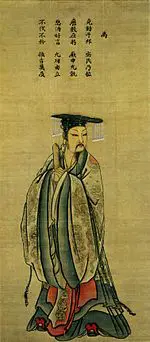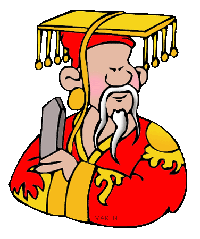Chinese History
Ancient China was built along the two main rivers—first the Yellow River (Huang He) in the north, and later the Yangtze in the south.

China is one of the oldest civilizations. Records of the Grand Historian (ca. 100 BC) and Bamboo Annals emphasized the existence of Xia Dynasty before the Shang dynasty.
The Xia dynasty:
 King Yu was the founder of this dynasty. King Yu was the first king to be succeeded by his son instead of a man chosen for his credentials. Xia dynasty was the first to irrigate, produce cast bronze and a strong army. It used oracle bones and had a calendar.
King Yu was the founder of this dynasty. King Yu was the first king to be succeeded by his son instead of a man chosen for his credentials. Xia dynasty was the first to irrigate, produce cast bronze and a strong army. It used oracle bones and had a calendar.
Xi Zhong who was the legendary minister of Xia dynasty, had invented a chariot during the 2nd millennium BC. The fall of the Xia is due to its last king, Jie, who is said to have fallen in love with an evil, beautiful woman and had become a tyrant.
The people rose up in rebellion under the leadership of Tang who was also the founder of the Shang Dynasty.

Shang dynasty:
Emperor Tang was the founder of this dynasty. During his rule, his subjects led a happy and peaceful life. A number of things associated with classical Chinese civilization were already evident in the Shang i.e. ancestor worship, an extremely high level of craftsmanship, written language with characters, not an alphabet; silk, jade and bronze.

Chou/Zhou dynasty:
Wu wang was the founder of Chou dynasty. This dynasty ruled for the longest period. The great philosophers also flourished during this period.
They banned human sacrifice. This period was divided into Eastern Zhou and Western Zhou. The Eastern Zhou was further divided into Spring and Autumn periods and the Warring States period. Later both these periods saw war. Finally Qin defeated the other six states that existed during the Warring States period and combined China.

Qin dynasty:
Qin Shi Huang became the first emperor of unified China. The emperor was a legalist; he burnt all the books except those on agriculture, divination, forestry and medicine. The Qin Dynasty is well known for beginning the Great Wall of China, which was later extended and enhanced during the Ming Dynasty.
The other major contributions of the Qin include the concept of a centralized government, the unification of the legal code, development of the written language, measurement, and the currency of China. Trade was made easier by standardizing width of the cart wheels.
The “Terracotta army” was made for the tomb of Qin Shi Huang to serve and guard him in the afterlife. An estimated 8,000 life-size figures of warriors, each one different, stand in rows in his tomb.

Han dynasty:
The founder of this dynasty was Liu Bang. This dynasty was divided into the earlier Western Han dynasty and the later Eastern Han dynasty. The Han Dynasty was a period of peace and prosperity as many effective measures were taken by the emperors during their rule.

The Six dynasties:
The turbulent 6 dynasties period of ancient China ran from the end of the Han dynasty in A.D. 220 to the conquest of southern China by the Sui in 589 AD.
The 6 dynasties who held power for three and a half centuries were:
• Wu (222 AD–280 AD)
• Dong (Eastern) Jin (317AD–420 AD)
• Liu-Song (420 AD–479 AD)
• Nan (Southern) Qi (479 AD–502 AD)
• Nan Liang (502 AD–557 AD)
• Nan Chen (557 AD–589 AD).

Sui dynasty:
The Sui Dynasty was a short-lived dynasty running from A.D. 581 to 618 that had its capital at Daxing, which is now Xian.
Tang dynasty:
The Tang Dynasty, following the Sui and preceding the Song Dynasty, was a golden age period that lasted from A.D. 618–907 and is considered the peak point in Chinese civilization.

Five Dynasties:
The period of the five dynasties lasted for only 53 years, from 907 AD to 960 AD. The Five Dynasties comprised a string of dynasties in northern China that succeeded one another from 907 AD to 960 AD.
The Five Dynasties were the Later Liang Dynasty, Later Tang Dynasty, Later Jin Dynasty, Later Han Dynasty, and Later Zhou Dynasty. After the death of the Later Zhou emperor and the forced resignation of his son, the Song dynasty came into power.

Song dynasty:
Song dynasty was founded by General Zhao Kuang-yin. This first emperor of the Song dynasty was put on the throne by his own troops in Kaifeng. He slowly reconquered all of China.
The cruel custom of binding young girls’ feet to make them small started during this period. It began in the upper classes, and eventually spread to all other classes.
It was during the rule of Song dynasty, that China became a world leader in science and technology. Also inventions such as typography and compass were made during this period.

Yuan Dynasty (1271 AD–1368 AD): After the Mongols defeated the people of Song dynasty in a long war, Kublai Khan, a Mongol leader, established the Yuan dynasty.
Ming Dynasty (1368 AD–1644 AD): The last of the great Chinese dynasties, the Ming dynasty finished the Great Wall and built the Forbidden City, an enormous palace for the Emperor. The Ming dynasty came into power by overthrowing the rule of the Mongols.

Qing dynasty (1644 AD–1911 AD): The last emperor of the Ming dynasty hanged himself when army of peasants led by Li Zicheng entered Beijing. The Manchus invaded China in 1644 AD and defeated the army led by Li Zicheng. This way Manchus set up a new dynasty called the Qing dynasty. This dynasty ruled China for the next 300 years. Qing dynasty was succeeded by Republic of China thus ending the period of ancient dynasties.
Life in Ancient China was most difficult for the farmers. They worked day and night, yet the land they worked on did not belong to them. The land belonged to the kings. Farmers lived in huts. Their diet mainly consisted of wheat and rice.

China was a male dominating country. The male member of the house dictated terms in the house. Women had to obey orders of the male member of the house. Girls were not sent to schools. While boys were sent to schools where they learnt teachings of Confucius and calligraphy.
Chinese art, culture, and religion were often tied together. There were three main religions or philosophies which were Taoism, Confucianism, and Buddhism. These ideas, called “the three ways” had a large impact on the way people lived as well as their art. Art focused on “the three perfections”; painting, poetry, and calligraphy.

Inventions in Ancient China: The ancient Chinese people had invented paper and printing press that led to development of calligraphy and literature. Their other notable inventions include compass, gunpowder, seismoscope, glider, noodles, sericulture, silk clothing, bank notes, and medicinal practices, such as Acupuncture. A number of military technologies, irrigation methods, were also prevalent in ancient China.


